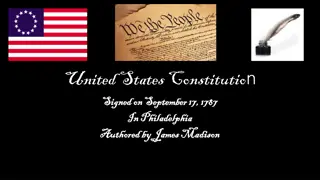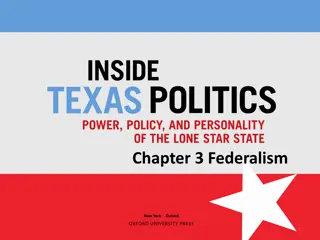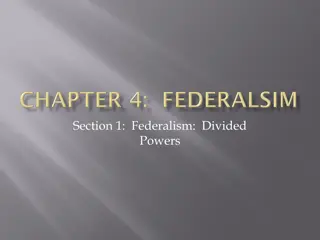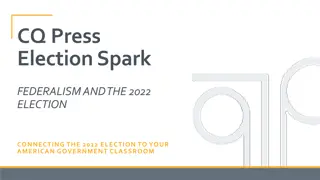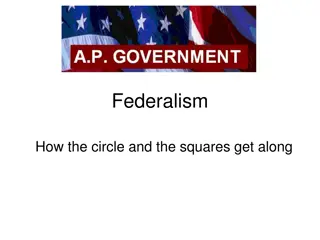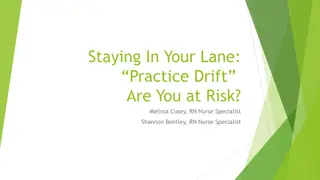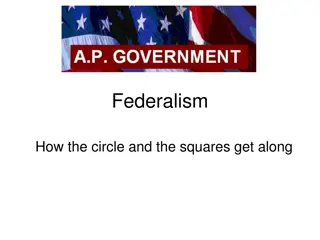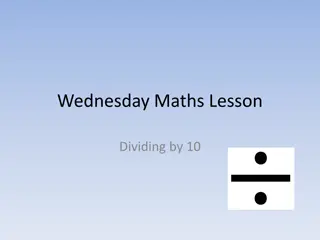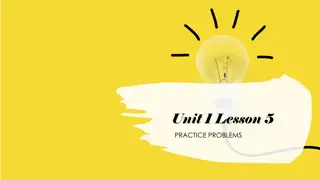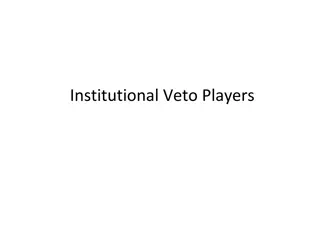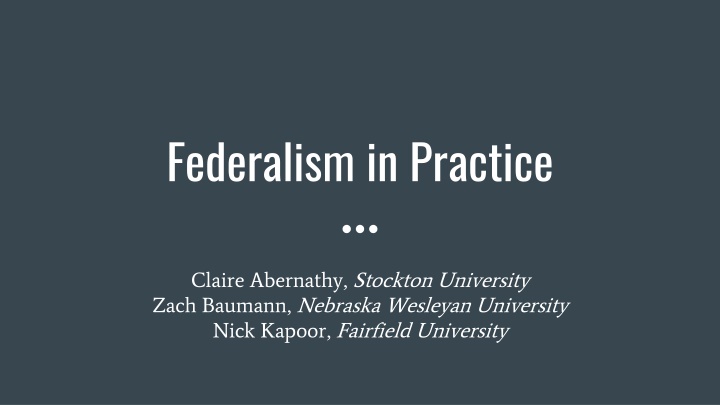
Federalism in Practice Lesson Plan
This lesson plan covers the responsibilities and powers of legislative bodies at local, state, and federal levels, guiding students to identify their representatives and engage with Congress effectively. The structured session includes activities on Congress, state legislatures, and local legislatures, emphasizing civic engagement and active learning.
Download Presentation

Please find below an Image/Link to download the presentation.
The content on the website is provided AS IS for your information and personal use only. It may not be sold, licensed, or shared on other websites without obtaining consent from the author. If you encounter any issues during the download, it is possible that the publisher has removed the file from their server.
You are allowed to download the files provided on this website for personal or commercial use, subject to the condition that they are used lawfully. All files are the property of their respective owners.
The content on the website is provided AS IS for your information and personal use only. It may not be sold, licensed, or shared on other websites without obtaining consent from the author.
E N D
Presentation Transcript
Federalism in Practice Claire Abernathy, Stockton University Zach Baumann, Nebraska Wesleyan University Nick Kapoor, Fairfield University
Learning Objectives: By the end of this Learning Objectives: By the end of this lesson, students should lesson, students should Understand basic responsibilities and powers of legislative bodies at the local, state and federal levels Identify their representatives at the local, state and federal level and how to connect with them Federalism in Practice 75 75- -minute class session minute class session 1-2 minutes Motivating Question/Introduction Motivating Question/Introduction 10-15 minutes Congress Mini Congress Mini- -Lecture Lecture 5-10 minutes Congress Activity Congress Activity 10-15 minutes State Legislatures Mini State Legislatures Mini- -Lecture Lecture 5-10 minutes State Legislatures Activity State Legislatures Activity 10-15 minutes Local Legislatures Mini Local Legislatures Mini- -Lecture Lecture 5-10 minutes Local Legislatures Activity Local Legislatures Activity 15-20 minutes Who Solves My Problem? Who Solves My Problem?
Federalism in Practice In this federalism lesson plan, we are applying what we have discussed throughout the APSA Symposium on Teaching & Learning the Introduction to American Politics course including: Integrating active learning Emphasizing civic engagement Our goal is to develop a one-day lesson that can be easily incorporated into an Introduction to American Politics course. This lesson can also be tailored to a university s appropriate state and local context. Our materials for APSA Educate will also include discussion prompts or resources for additional related topics (i.e. representation, political participation, etc.) that faculty may want to tie into this lesson.
Learning Objectives Learning Objectives Understand basic responsibilities and powers of House and Senate Recognize what issues fall within Congress s jurisdiction Identify Representative and Senator Practice researching actions taken by Members of Congress Legislature at the Federal Level: Congress (Outline) Structure of Congress Powers defined in Article I of the Constitution Qualifications to hold office in Congress Current demographics of House and Senate Congress as professionalized legislature (full-time, staff support, etc.) How you can engage with Congress Activity Activity: : Who represents you in the House and Senate? What have your Representative and Senators been working on recently?
Legislature at the Federal Level: Congress Bicameral legislature House of Representatives. 435 members who represent the population of congressional districts within states. Senate. 100 members, two for each state, who represent the population of their states. Powers defined in Article I of the Constitution Policymaking and Casework responsibilities Qualifications to hold office in Congress House of Representatives. At least 25 years old, a citizen for at least 7 years, and living in the state they represent Senate. At least 30 years old, a citizen for at least 9 years, and living in the state they represent
Legislature at the Federal Level: Congress (Activity!) Who represents you in the House and Senate? We are each represented by one Representative (who represents the congressional district we live in) and two Senators (who represent the state we live in) Find your Representative and Senators What have your Representative and Senators been working on recently? Visit their websites to find out!
Learning Objectives Learning Objectives States make a number of policy decisions that affect our daily lives States vary in who holds office and is allowed to serve States vary in their policymaking capacity Identify and know how to contact your state legislator Legislature at the State Level (Outline) State policymaking authority is found in the US Constitution, their own constitutions, and the actions of courts State legislatures are not all the same what does yours look like? States vary in who is qualified to serve and who holds office what does this look like in your state? State vary in their capacity to engage in policymaking and oversight Activity Activity: : Who represents you in the state legislature and how can you contact them? What bills have the sponsored (or cosponsored) recently?
Legislature at the State Level The capacity of state legislatures to create policy and conduct oversight varies Staff they are allowed to hire Salary (ability to treat lawmaking as a full-time job) Length of their sessions In the absence of policymaking capacity, legislators may turn to information from governors, bureaucrats, and lobbyists Legislators must be strategic in determining where to spend their time/resources How does this affect your strategy for approaching your state lawmaker? National Council of State Legislatures (2021)
Legislature at the State Level (Activity!) Who represents you in the state legislature? Go to the website of your state legislature and find your elected representatives. Identify a way of contacting their office (email, phone number, physical address). What have they been up to lately? Use the state legislature s website to search bill introductions what has your member sponsored/cosponsored?
Government at the Local Level: (Outline) Learning Objectives Learning Objectives Understand the widely varied nature of local government across the United States Why would a student call a member of the local government? Identify local legislators or Mayor Find out how to contact local officials Structure of Local Government (City/County) ~90,000 local governments (Executive, Legislative, Other Bodies ) Local Charters/Governing Documents (Local Constitutions ) Who are local politicians? Give local government context in your state How you can engage with your local government Activity Activity: : What type of local government does your town/city have? Who represents you in your local legislature or is your Mayor? What was on the last agenda of your local legislature?
Government at the Local Level - Connecticut (Sample State) Connecticut is one of 2.5 states that do not have county government (RI and Western MA being the other 1.5). Every single municipality (town/city) in Connecticut from the largest (Bridgeport - pop. 148,654) to the smallest (Union - pop. 785) has a Chief Executive Officer - an elected Mayor or First Selectman, or an appointed Town Manager that runs the town. Every single municipality in Connecticut has a local legislature in one of three forms: City Council/Town Council/Board of Alderman (typically 7 - 13 members, larger in the cities) Representative Town Meeting (larger bodies - typically 30 - 230) Town Meeting (all town residents) All local elections in Connecticut are partisan. This is unusual. Hartford has a full-time city council with full- time salaries and staff. A couple other towns give stipends to their councilmembers. The vast majority are volunteers. The average budget in a CT municipality is 66% Education and 34% municipal.
Government at the Local Level: Activity! Try to find the local (county or town/city) government website for your hometown.* *If you live outside of the United States, feel free to find representatives that represent you in the locality of your home country, or if those people cannot be found, feel free to use the national government from your home country. Find members of the local legislature of your local government and their last agenda. What were they talking about? Anything interesting? Think about a few particular problems that you would send to a local official in your town and/or county.
Who Solves My Problem? (Activity!) In this activity, students will decide which level of government is the most appropriate to address different problems. 1. Present students with mock problems and discuss which level should address each problem 2. Have students (anonymously) write down a problem they have that local, state or federal legislature could address 3. Collect student problems and compile on the board or using technology like Quip or Padlet 4. In small groups, students discuss which problem goes to which level of government
Who Solves My Problem? (Activity!) Jake is worried about the effects of climate change and he wants to make it easier for people to cut back on their own carbon emissions. He s interested in seeing new programs to incentivize people to buy electric cars and to build more electric car charging stations across the country. On a walk at the park, Alyssa saw that seniors were having trouble crossing a busy road from a side street where resident park their cars to the main park area. She would like to see a crosswalk installed and perhaps an additional stop sign to slow traffic down and allow people to cross the road safely. You re concerned that polls open on Election Day at 8:00 a.m., making it difficult for those with families to participate. You would like the polls to open at 7:00 a.m. so people can vote before going to work.



